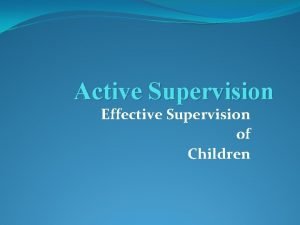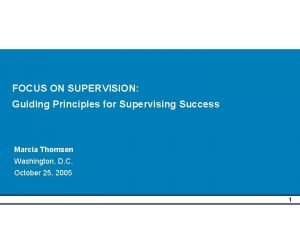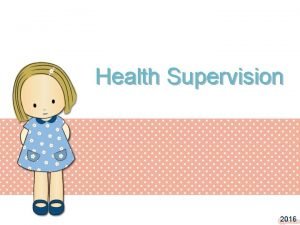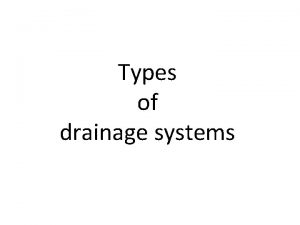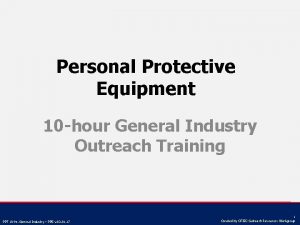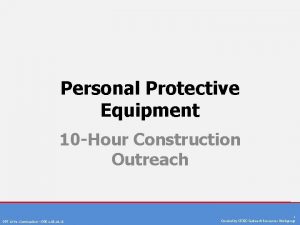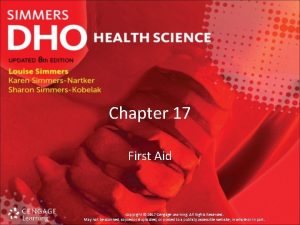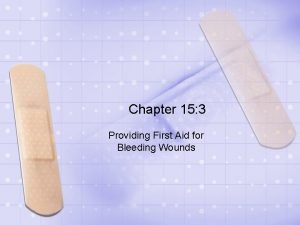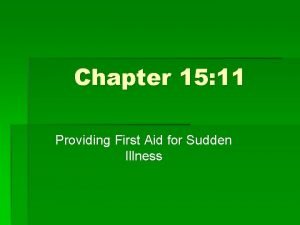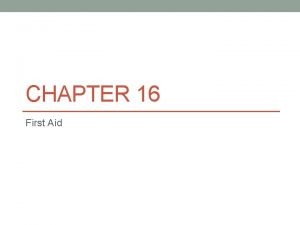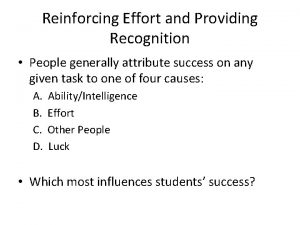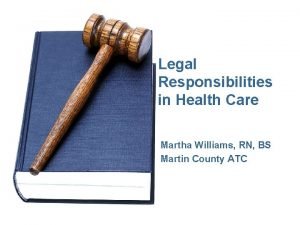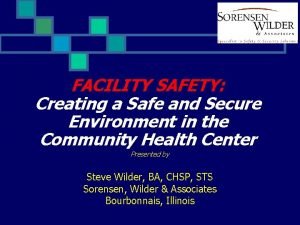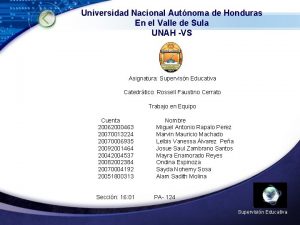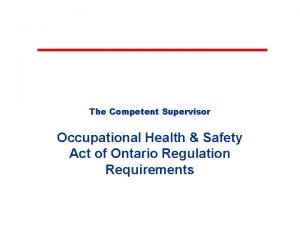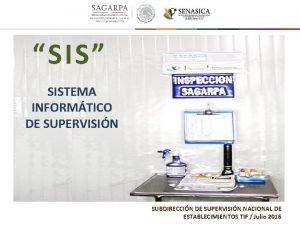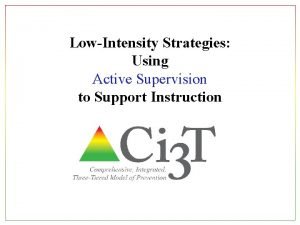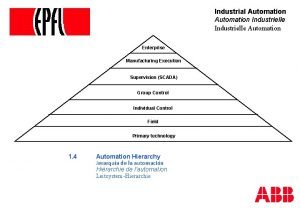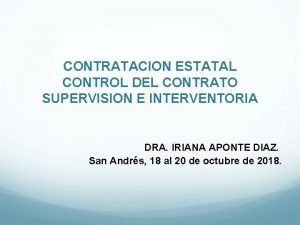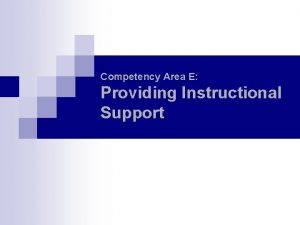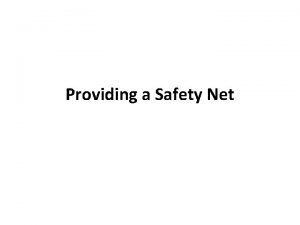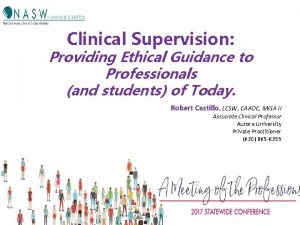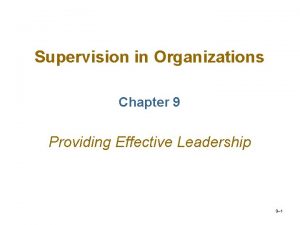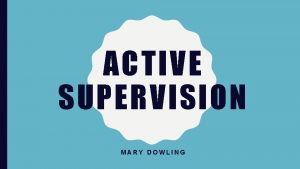Health Supervision 2016 Principles of Health Supervision Providing



















































- Slides: 51

Health Supervision 2016

Principles of Health Supervision • Providing services proactively • Optimizing child’s level of functioning • Ensuring child is growing and developing appropriately • Promoting best possible health of child • Preventing injury and illness through child teaching • Organizations which provide guidelines and framework for the health supervision – DHHS (U. S. Dept of Health and Human Services) – AMA and AAP

Community Settings • The nurse has a key role in health screening and surveillance: – Pay attention to voiced parental concerns – Ask questions about child’s growth and development – Observe child’s mental, physical, and spiritual state (not just diagnosed condition) – Note any risk factors that may be present – Document specific observations and findings – Provide community resources and make appropriate referrals – Track disease incidence and demographics of illnesses – Implement policies that may prevent further spread of diseases – Initiate follow-up care for any concerns and conditions

Community Settings (cont’d) Places in the community where children and their families can access health care: – State health program – Department of Health and Human Services – Specialty camps – Churches, synagogues, mosques – Mobile health care unit – Rehabilitation service – School setting • Primary health-care provider’s office or clinic – Community centers – Preventative medicine center – Home health care – Medical home

Community Settings (cont’d) In a community, there can be one general care clinic or many types of specialty clinics: – Allergy and asthma clinic – Audiological clinic – Cardiology clinic – Diabetes clinic – Eating disorders clinic – Endocrinology clinic – Gastroenterology— nutrition clinic – Genetics clinic – Immunology clinic – Infectious disease clinic – Neurology clinic – Oncology clinic – Ophthalmology clinic – Orthopedics clinic – Pulmonary/cystic fibrosis clinic – Rheumatology clinic – Urology clinic

Community Settings (cont’d) • Health screenings – Community settings often provide primary care along with health screening and surveillance – Health screening is a way to test or examine children for presence of disease, illness, chronic condition, developmental delays, or mental health issues – Health surveillance is the continuous observation related to tracking health conditions and risk behaviors

Community Settings (cont’d) • Benefits of a medical home – Child regularly sees same primary care physician and staff – Coordination of care for the child – Open exchange of information in honest and respectful manner – Support for finding resources and information related to all stages of growth and development and medical conditions – Family is connected to information and family support organizations

Characteristics of a Medical Home

Benefits of Health Partnerships With Child, Parents, and Community • Child is the focus of the health supervision visit, BUT. . . • The family and community is strongly linked • Mutual goal setting • Marshalling of resources • Development of optimal health practices

Special Issues in Health Supervision • Cultural influences • Community influences – Has unique strengths, weakness, and values – Can be a contributor of child’s health or a detriment • Health supervision and the chronically ill child – Must be responsive to the individual child’s situation – Child needs to be reassessed constantly – This will determine frequency of visits and types

Special Issues in Health Supervision (cont) • Health supervision and the internationally adopted child – Comprehensive screening for infectious diseases • • • Intestinal parasites Tuberculosis Hep B HIV Syphilis

Let’s look at who might be at risk for developmental delay • • • BW < 1, 500 g Gestational age < 33 wks CNS abnormality Hx of hypoxia Mom’s ETOH abuse Mom’s Drug abuse Hyperbilirubinemia Congenital abnormalities Inborn error of metabolism • Chronic otitis media with effusion • HIV infection • Lead level of 19 mg/dl • Uncaring parents to allow developmental delays to continue • Single parent • Sibling with delays • Parent with developmental disabilities or mental illness

Issues Covered in Psychosocial Assessments • • • Health insurance coverage Transportation to health care facilities Financial stressors Family coping School’s response to the chronic illness

Three Components of Health Supervision • Developmental surveillance and screening – Noting and addressing parental concerns – Obtaining a developmental history – Making accurate observations – Consulting with relevant professionals

Three Components of Health Supervision (cont) • Injury and disease prevention – Interventions meant to protect children from disease and risks • Risk assessment – Performed by physician – Includes objective and subjective data to determine likelihood child will develop a condition

Three Components of Health Supervision (cont) • Health promotion – Maintaining or enhancing physical and mental health of children – Identify risk factors – Facilitate lifestyle changes to eliminate or reduce those factors – Empower kids at both individual and community level

Types of Screening • Injury and disease prevention (cont) • Universal screening – Screening of an entire population regardless of the child’s individual risk – (like DENVER II) • Selective Screening – When a risk assessment indicates one or more risks – Done when a risk assessment indicates the child has one or more risk factors for a disorder

Screenings Conducted at the Health Supervision Visit • • • History and physical assessment Developmental/behavioral assessment Sensory screening (vision and hearing) Appropriate at-risk screening Immunizations Health promotion

Specific Types of Screenings Performed • Metabolic – Some states have mandatory screenings – Several examples shown on Page 243 – Let’s look! • Hearing – Looking at 3 months to 4 years – Weber (bone conduction) and Rinne (sound conduction) •

Criteria for Risk Assessment for Hearing Loss (Age 3 Month to 5 Years) • • • Auditory skill monitoring Developmental surveillance Assessment of parental concerns Older than 4 years old Difficulty hearing on the telephone Difficulty hearing people in a noisy background • Frequent asking of others to repeat themselves • Turning the television up too loudly

Specific Types of Screenings Performed • Vision – Age appropriate picture chart – SNELLEN after age 6 when they know the alphabet • Iron-deficiency anemia • Lead – Still a problem despite 30 yr regulation – Historic homes or homes not stripped last 3 decades – MEDICAID kids at risk 80% needs to be screened • Hypertension- Obesity • Hyperlipidemia

Using a Vision Screening Chart • Place the chart at the child’s eye level. • Place a mark on the floor 20 feet from the chart. • Align the child’s heels on the mark. • Have the child read each line with one eye covered and then with the other eye covered. • Have the child read each line with both eyes.

Vision Screening Chart

Immunizations • KEY PREVENTIVE ACTIVITY • 1940 s – kids started really surviving their childhood • Shifted from, “disease treatment” to, “disease prevention” As a nurse, YOU need to: • Understand the principles of immunizations • Proper use of vaccines • Barriers to immunizations

Immunity • Immunity – Ability to destroy and remove a specific antigen from the body • Passive immunity – Produced when the immunoglobulins of one person are transferred to another • Active immunity – Acquired when a person’s own immune system generates the immune response

Types of Vaccines • Live attenuated vaccines – Live but modified that weakens it – Produce a good immune response but. . . NOT the complications • Killed vaccines – Whole dead organisms incapable of reproducing but. . . produces an immune response

Types of Vaccines (cont) • Toxoid vaccines – Contain protein products produced by bacteria (toxins) – Is heat treated to weaken its effect but. . . retains ability to produce immune response • Conjugate vaccines – Increases the immune response by chemically linking the bacterial wall with proteins

Types of Vaccines (cont) • Recombinant vaccines – Genetically engineered organisms – Splices the gene portion of the virus into a gene of a yeast cell – Yeast cell is then able to produce a surface antigen to use for vaccine to produce an immune response

Live attenuated vaccines consist of live bacteria or virus which have been rendered avirulent • The 8 live vaccines are – – – – 1. BCG Ty-21 a 3. OPV 4. Measles 5. Mumps 6. Rubella 7. Varicella 8. Yellow fever

Vaccine Administration Routes Adapted from Immunization Action Coalition. (2009). Administering vaccines: Dose, route, site, and needle size. Retrieved April 17, 2011, from http: //www. immunize. org/catg. d/p 3085. pdf. We thank the Immunization Action Coalition.

Types of Vaccines • http: //www. vaccineinformation. org/ • • • Diphtheria, tetanus, and pertussis Haemophilus influenzae type B Polio, measles, mumps, and rubella Hepatitis A and B Varicella Pneumococcal and influenza Rotavirus Human papillomavirus Meningococcal


6


Barriers to Immunizations • Parental concerns about vaccine safety • Fact: the more kids in a family the less likely subsequent kids get immunized • The cost of vaccines • Wanting to postpone some because of concern of multiple vaccines • Fact: disrupting optimal spacing of immunizations can decrease efficacy

Overcoming Barriers • • • Combined: MMR (measles, mumps, rubella) Comvax (Hep B –Hib) Pediarix (DTa. P – Hep. B – IPV) Pentacel (DTa. P – IPV/Hib)

Topics for Anticipatory Guidance • • • Promoting oral health care Promoting healthy weight Promoting healthy activity Promoting personal hygiene Promoting safe sun exposure

Oral Hygiene • When New Teeth Arrive • First primary or baby teeth will begin to erupt between the ages of six to eight months • Continues to erupt until about age three. • During this time, gums may feel tender and sore. To help alleviate this discomfort, soothe gums by rubbing a clean finger or a cool, wet cloth across them. • Teething ring. • When finished teething, a total of 20 primary teeth is expected.

Oral Hygiene • Sugary foods and liquids can attack a new tooth, so brushing early after feeding or eating (four times a day for optimal oral hygiene: after breakfast, after lunch, after dinner, and at bedtime). • When a baby's tooth erupts, parents should brush the tooth with a soft-bristled toothbrush and a pea-sized amount of toothpaste.

Oral Hygiene • For children younger than two, do not use fluoride toothpaste unless advised to do so by your dentist or other healthcare professional. • Flossing is also a part of good oral hygiene habits • Children should visit the dentist by their first birthday.

Personal Hygiene • Encourage parents to allow child to get involved with personal hygiene early • Age specific • Parent needs to follow up

Sun Safety • Play in shade or out of sun all together between the hours of 1000 and 1600 • Wear sunglasses and wide brim hat • Drink lots of water and keep cool • Cover with clothing not translucent • • No babies in the sun (before 6 mos) Use sunscreen (SPF 30 or higher) everyday, Apply between 15 and 30 mins before exposure Reapply q 2 hrs

The End

Question Is the following statement true or false? The community can be a contributor to a child’s health or it can be the cause of his or her illnesses.

Answer True. The community can be a contributor to a child’s health or it can be the cause of his or her illnesses. Rationale: The child is a member of a community as well as a family and a culture. The child’s health cannot be totally separated from the health of the surrounding community. Each community has unique strengths, weaknesses, and values that can affect a child’s health.

Question Is the following statement true or false? The nurse providing pediatric health supervision should focus on the illness of children.

Answer False. The nurse providing pediatric health supervision should focus on the wellness of children. Rationale: The health supervision visit provides an opportunity to maximize health promotion for the child, family, and community and nurses have the ability to promote optimal health during these encounters. Health supervision visits should be viewed as part of a continuum of

Question The nurse is conducting developmental surveillance on a child and his family. Which of the following is a component of this process? a. measuring the child’s head circumference b. administering vaccinations c. addressing parental concerns d. performing a physical assessment

Answer c. addressing parental concerns is a component of developmental surveillance. Rationale: Developmental surveillance is an ongoing collection of skilled observations made over time during health care visits and includes noting and addressing parental concerns. Measuring the head circumference, administering vaccinations, and performing a physical assessment are components of the

Question The nurse is preparing a child for a vision screening. How far would the nurse place the child from the chart? a. 5 feet b. 10 feet c. 15 feet d. 20 feet

Answer d. 20 feet. The nurse would place the child 20 feet from the vision screening chart. Rationale: When screening for vision, the nurse would place the chart at the child’s eye level, place a mark on the floor 20 feet from the chart, and align the child’s heels on the mark.
 Objectives of supervision
Objectives of supervision Guiding principles of supervision
Guiding principles of supervision Definition of health supervision
Definition of health supervision Supervision and appraisal
Supervision and appraisal New zealand health strategy 2016
New zealand health strategy 2016 Unit 15:6 providing first aid for burns
Unit 15:6 providing first aid for burns Single pipe system
Single pipe system Setting objectives and providing feedback
Setting objectives and providing feedback Feedback dylan wiliam
Feedback dylan wiliam Describe the services delivered by a valet or butler
Describe the services delivered by a valet or butler Provide housekeeping services to guests
Provide housekeeping services to guests Foot protection example
Foot protection example Protective equipment in sports ppt
Protective equipment in sports ppt Reinforcing effort and providing recognition examples
Reinforcing effort and providing recognition examples Chapter 17:5 providing first aid for poisoning
Chapter 17:5 providing first aid for poisoning Chapter 17:1 providing first aid
Chapter 17:1 providing first aid Chapter 15:3 providing first aid for bleeding and wounds
Chapter 15:3 providing first aid for bleeding and wounds Chapter 17:11 providing first aid for sudden illness
Chapter 17:11 providing first aid for sudden illness Difference between ra 7836 and ra 9293
Difference between ra 7836 and ra 9293 An organization providing an entrance ramp to internet
An organization providing an entrance ramp to internet Reinforcing effort and providing recognition
Reinforcing effort and providing recognition Usmc counseling sheet
Usmc counseling sheet Chapter 16:5 providing first aid for poisoning
Chapter 16:5 providing first aid for poisoning Does providing a good value mean selling at a low price
Does providing a good value mean selling at a low price Assigning homework and providing practice
Assigning homework and providing practice Providing support services facilities and other amenities
Providing support services facilities and other amenities Leadership involves providing
Leadership involves providing Time-temperature abuse definition
Time-temperature abuse definition Reinforcing effort
Reinforcing effort Dr martha williams
Dr martha williams Providing improper or unprofessional treatment or care
Providing improper or unprofessional treatment or care Safe and secure environment
Safe and secure environment Sinaseh
Sinaseh Glickman's developmental supervision model
Glickman's developmental supervision model Competent supervisor
Competent supervisor Programas de supervisión
Programas de supervisión Objectives of supervision
Objectives of supervision Elt general supervision kuwait
Elt general supervision kuwait Special supervision
Special supervision Manual de supervision tif
Manual de supervision tif Supervision active et passive
Supervision active et passive Dr stepputat traunstein
Dr stepputat traunstein التوجيه الفني للغة الانجليزية
التوجيه الفني للغة الانجليزية General elt
General elt Market conduct supervision
Market conduct supervision Margaret morrell supervision training
Margaret morrell supervision training Active supervision checklist
Active supervision checklist Kollegial sparring og supervision
Kollegial sparring og supervision Industrial automation hierarchy
Industrial automation hierarchy Level of supervision rcog 1-5
Level of supervision rcog 1-5 Direct supervision model
Direct supervision model Supervisión de contratos ley 1474 de 2011
Supervisión de contratos ley 1474 de 2011
